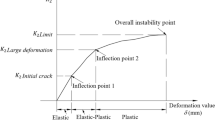Abstract
A seismic stability assessment of arch dam-foundation systems is presented using a comprehensive approach, in which the main factors that significantly influence the seismic response of an arch dam-foundation system are considered. A large scale finite element model with over 1 million degrees of freedom is constructed for the Baihetan arch dam (289 m high), which is under construction in the Southwest of China. In particular, the complicated geological conditions with faults intersecting interlayer shear weakness zones at the dam base and the dam abutment resisting force body is modeled in the analysis. Three performance indices are adopted to assess the seismic stability of the arch dam. The results demonstrate that the opening of the joints of the Baihetan arch dam is small and the water stop installed between the joints would not be torn during a design earthquake. The yielding formed in the interface between the dam and foundation does not reach the grouting curtain that would remain in an elastic state after an earthquake. The yielding zones occurring on the upper portion of the dam faces extend 1/8 thickness of block section into the dam body and thus cantilever blocks need not be concerned with sliding stability. The faults and interlayer shear weakness zones in the near field foundation exhibit severe yielding, and a potential sliding surface is penetrated. Although the factor of safety against sliding of the surface fluctuates with a decreased trend during an earthquake, the minimum instantaneous value reaches 1.02 and is still larger than 1.0. Therefore, a conclusion is drawn that the Baihetan arch dam-foundation system will remain stable under the design earthquake.
Similar content being viewed by others
References
Chopra AK (2012), “Earthquake Analysis of Arch Dams: Factors to Be Considered,” Journal of Structural Engineering, 138(2): 205–214.
Clough R and Ghanaat Y (1987), “Experimental Study of Arch Dam-reservoir Interaction,” Proceedings of Joint China-US Workshop on Earthquake Behavior of Arch Dams, Beijing, China.
Fenves GL, Mojtahedi S and Reimer RB (1992), “Effect of Contraction Joints on Earthquake Response of an Arch Dam,” Journal of Structural Engineering, ASCE, 118(4): 1039–1055.
Hariri-Ardebili MA and Mirzabozorg H (2013), “A Comparative Study of Seismic Stability of Coupled Arch Dam-foundation-reservoir Systems Using Infinite Elements and Viscous Boundary Models,” International Journal of Structural Stability and Dynamics, 13(06): 1350032.
Hariri-Ardebili M, Mirzabozorg H and Kianoush MR (2013), “Seismic Analysis of High Arch Dams Considering Contraction-peripheral Joints Coupled Effects,” Central European Journal of Engineering, 3(3): 549–564.
Jin F, Hu W, Pan J et al. (2011), “Comparative Study Procedure for the Safety Evaluation of High Arch Dams,” Computers and Geotechnics, 38(3): 306–317.
Lau DT, Noruziaan B and Razaqpur AG (1998), “Modelling of Contraction Joint and Shear Sliding Effects on Earthquake Response of Arch Dams,” Earthquake Engineering and Structural Dynamics, 27: 1013–1029.
Lebon G, Saouma V and Uchita Y (2010), “3d Rockdam Seismic Interaction,” Dam Engineering, 21(2): 101.
Lee J and Fenves LG (1998), “Plastic-damage Model for Cyclic Loading of Concrete Structures,” Journal of Engineering Mechanics, ASCE, 124(3): 892–900.
Liu J, Du Y, Du X et al. (2006), “3D Viscous-spring Artificial Boundary in Time Domain,” Earthquake Engineering and Engineering Vibration, 5(1): 93–102.
Lotfi V and Espandar R (2004), “Seismic Analysis of Concrete Arch Dams by Combined Discrete Crack and Non-orthogonal Smeared Crack Technique,” Engineering Structures, 26(1): 27–37.
Mirzabozorg H and Ghaemian M (2005), “Non-linear Behavior of Mass Concrete in Three-dimensional Problems Using a Smeared Crack Approach,” Earthquake Engineering & Structural Dynamics, 34(3): 247–269.
Pan J, Xu Y and Jin F (2015), “Seismic Performance Assessment of Arch Dams Using Incremental Nonlinear Dynamic Analysis,” European Journal of Environmental and Civil Engineering, 19(3): 305–326.
Pan J, Zhang C, Wang J et al. (2009), “Seismic Damagecracking Analysis of Arch Dams Using Diff erent Earthquake Input Mechanisms,” Science in China Series E-Technological Sciences, 52(2): 518–529.
Pan J, Zhang C, Xu Y et al. (2011), “A Comparative Study of the Different Procedures for Seismic Cracking Analysis of Concrete Dams,” Soil Dynamics and Earthquake Engineering, 31(11): 1594–1606.
Valliappan S, Yazdchi M and Khalili N (1999), “Seismic Analysis of Arch Dams—a Continuum Damage Mechanics Approach,” International Journal For Numerical Methods in Engineering, 45(11): 1695–1724.
Wang JT, Zhang CH and Jin F (2012), “Nonlinear Earthquake Analysis of High Arch Dam-waterfoundation Rock Systems,” Earthquake Engineering & Structural Dynamics, 41(7): 1157–1176.
Zhang CH and Jin F (2008), “Seismic Safety Evaluation of High Concrete Dams Part I: State of the Art Design and Research,” 14WCEE, S13–080, Beijing, China.
Zhang C, Pan J and Wang J (2009), “Influence of Seismic Input Mechanisms and Radiation Damping on Arch Dam Response,” Soil Dynamics And Earthquake Engineering, 29(9): 1282–1293.
Zhang C, Wang G and Zhao C (1988), “Seismic Wave Propagation Effects on Arch Dam Response,” 9th World Conference on Earthquake Enginnering, Tokyo-Kyoto, VI: 367–372.
Zhang C, Xu Y, Wang G et al. (2000), “Non-linear Seismic Response of Arch Dams with Contraction Joint Opening and Joint Reinforcements,” Earthquake Engineering and Structural Dynamics, 29: 1547–1566.
Zhang CH, Xu YJ, Wu MX et al. (2012), “The Performance of High Dams in Wenchuan 5-12 Earthquake and Follow-up Analysis of the Shapai Arch Dam during the Event,” 15WCEE, Lisbon, Portugal.
Zhong H, Lin G, Li X et al. (2011), “Seismic Failure Modeling of Concrete Dams Considering Heterogeneity of Concrete,” Soil Dynamics and Earthquake Engineering, 31(12): 1678–1689.
Author information
Authors and Affiliations
Corresponding author
Additional information
Supported by: National Natural Science Foundation of China under Grant Nos. 51209120, 51579133 and 51323014, and the Tsinghua University Initiative Scientific Research Program under Grant No. 20131089285
Rights and permissions
About this article
Cite this article
Pan, J., Xu, Y., Jin, F. et al. Seismic stability assessment of an arch dam-foundation system. Earthq. Eng. Eng. Vib. 14, 517–526 (2015). https://doi.org/10.1007/s11803-015-0041-2
Received:
Accepted:
Published:
Issue Date:
DOI: https://doi.org/10.1007/s11803-015-0041-2



